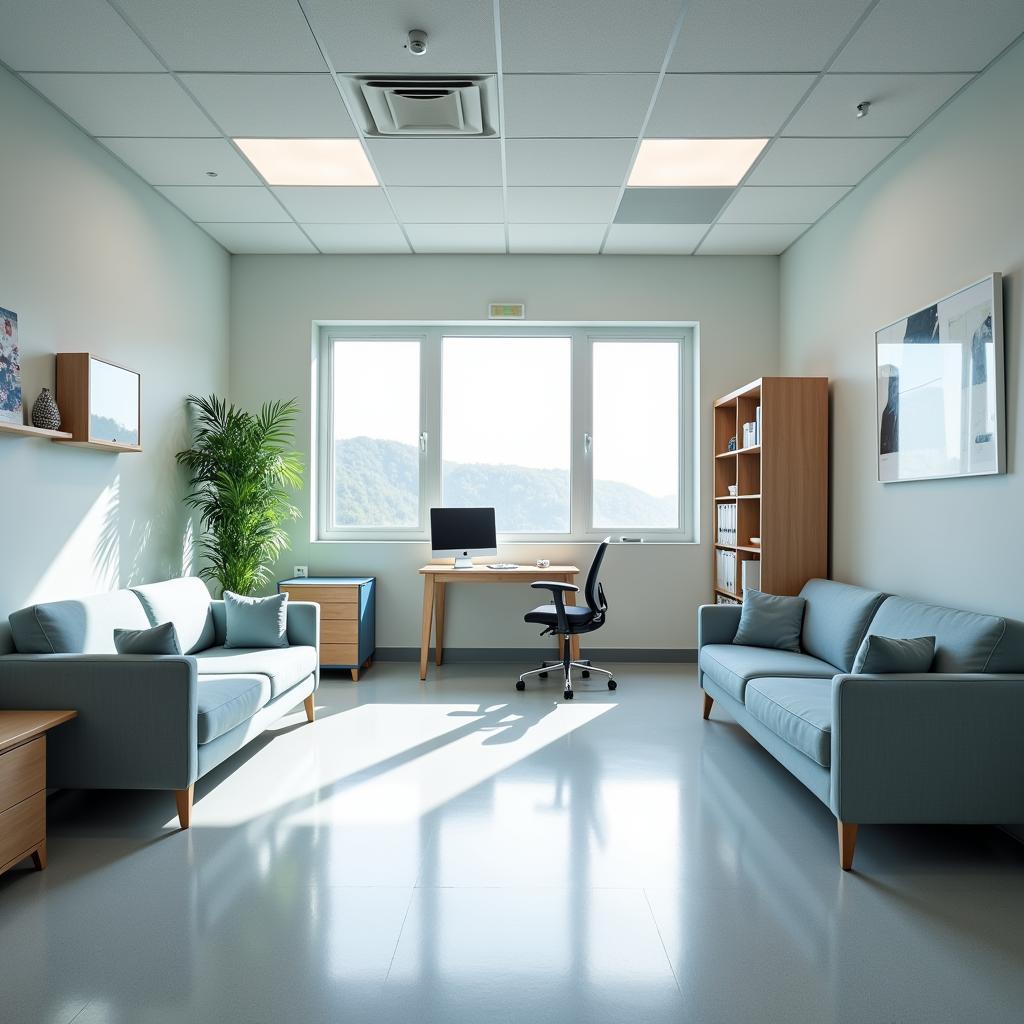For medical professionals, the hospital is more than just a workplace – it’s often a second home. Long shifts, unpredictable schedules, and the critical nature of healthcare necessitate having a dedicated space for rest and rejuvenation. This is where the importance of a well-designed and comfortable hospital on-call room comes into play.
 Modern Hospital On-Call Room Design
Modern Hospital On-Call Room Design
What is a Hospital On-Call Room?
A hospital on-call room is a designated area within a hospital that provides on-call medical staff with a place to rest, sleep, or attend to personal matters while they are not actively attending to patients. These rooms are crucial for ensuring that healthcare professionals can remain alert and responsive when they are needed, especially during long shifts or overnight stays.
Why are On-Call Rooms Essential for Hospital Staff?
Imagine a surgeon having to perform a complex procedure after being awake for 24 hours straight, or a nurse struggling to provide compassionate care after a series of back-to-back shifts. The consequences of fatigue in healthcare can be severe, impacting patient safety and the well-being of medical professionals.
Here’s why providing dedicated on-call rooms is not just about comfort, but about fostering a culture of safety and support:
- Reduced Medical Errors: Studies have consistently shown a strong correlation between physician fatigue and medical errors. A comfortable on-call room allows healthcare professionals to take breaks and get adequate rest, reducing the risk of errors caused by exhaustion.
- Improved Clinical Performance: When doctors, nurses, and other medical staff are well-rested, their cognitive function, decision-making abilities, and overall clinical performance improve. This translates to better patient care and outcomes.
- Enhanced Staff Morale and Retention: Providing a comfortable and private space for rest demonstrates a hospital’s commitment to the well-being of its staff. This can significantly improve morale, job satisfaction, and ultimately, staff retention rates.
What Makes a Good Hospital On-Call Room?
Creating a truly effective hospital on-call room goes beyond just providing a bed. It’s about understanding the needs of healthcare professionals and designing a space that promotes relaxation and rejuvenation.
Here are some key elements of a well-designed on-call room:
- Comfortable Sleeping Arrangements: A good quality bed with clean linens is essential. Adjustable beds can be particularly beneficial, allowing staff to customize their sleeping position.
- Privacy and Quiet: On-call rooms should be located in a quiet area of the hospital, away from noisy equipment and high-traffic areas. Soundproofing and blackout curtains can further enhance privacy and sleep quality.
- Essential Amenities: Small touches can make a big difference. Amenities like comfortable seating, a desk, Wi-Fi access, a mini-fridge, and a coffee maker can make the on-call room feel more like a home away from home.
- Cleanliness and Hygiene: Maintaining a high standard of cleanliness is crucial. On-call rooms should be cleaned and sanitized regularly to ensure a healthy and comfortable environment.
 Doctor Resting in a Well-Equipped On-Call Room
Doctor Resting in a Well-Equipped On-Call Room
Investing in On-Call Room Design: A Wise Decision for Hospitals
Investing in well-designed and comfortable on-call rooms is an investment in the well-being of medical professionals and, by extension, the safety and well-being of patients.
Hospitals that prioritize the needs of their staff by providing comfortable and functional on-call rooms are likely to see the benefits in the form of:
- Improved Patient Safety
- Enhanced Staff Productivity
- Increased Staff Retention
- Enhanced Hospital Reputation
“A well-rested doctor is a better doctor,” says Dr. Emily Carter, Chief of Staff at City General Hospital. “When hospitals invest in comfortable on-call rooms, they are investing in better patient care.”
By prioritizing the comfort and well-being of their medical staff, hospitals can create a work environment that fosters excellence in patient care and contributes to a healthier and more sustainable healthcare system.
FAQ: Common Questions about Hospital On-Call Rooms
1. Who is eligible to use the hospital on-call room?
On-call room availability varies by hospital, but they are generally reserved for physicians, residents, fellows, and other medical professionals who are required to be on-call for emergencies or patient care needs.
2. Are there any rules or guidelines for using the on-call room?
Yes, hospitals typically have specific rules regarding noise levels, cleanliness, and appropriate use of the on-call rooms. It’s essential to familiarize yourself with these guidelines to ensure a respectful and comfortable environment for everyone.
3. Can I bring personal belongings to the on-call room?
While you can usually bring personal items like toiletries, books, or electronics, it’s best to check with your hospital’s policy on personal belongings in on-call rooms. Some hospitals may have restrictions on certain items.
4. What happens if I need to leave the on-call room for an emergency?
Hospitals have protocols in place to ensure that on-call staff can be easily reached in case of an emergency. Typically, you’ll need to provide your pager number or contact information, and the hospital will have systems in place to notify you if needed.
5. Can I request a specific type of on-call room?
Some hospitals may offer different types of on-call rooms based on availability and seniority. While requests can be made, accommodation is not always guaranteed.
Need More Information?
For those interested in learning more about hospital amenities and patient care, we have several other informative articles you might find helpful:
Have other questions about healthcare services at San Jose Hospital? Don’t hesitate to contact us! We’re here to help you navigate your healthcare journey with ease and confidence.
Contact us:
Phone: 02437655121
Email: [email protected]
Address: Số 298 Đ. Cầu Diễn, Minh Khai, Bắc Từ Liêm, Hà Nội, Việt Nam.